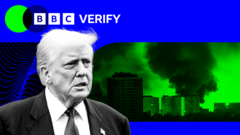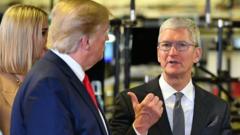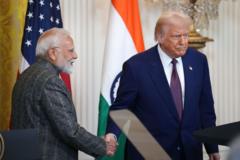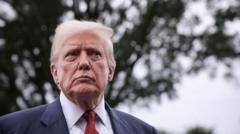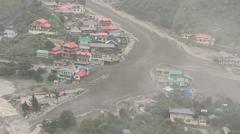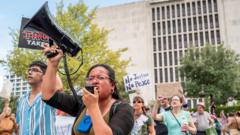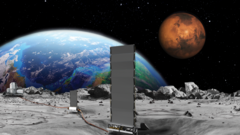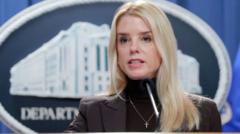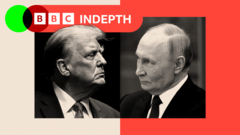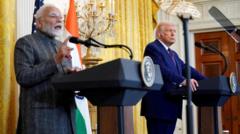Former allies now face diplomatic strife as Trump imposes steep tariffs on Indian imports, condemning Modi's ties with Russia and risking the long-standing partnership.
**Turbulence in US-India Relations: Trump's Tariffs Roil Trade Ties**
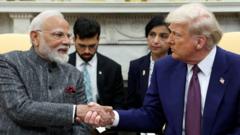
**Turbulence in US-India Relations: Trump's Tariffs Roil Trade Ties**
As tensions rise between the US and India, Donald Trump's new tariffs deepen the rift over energy policies.
In a remarkable turn of events, the relationship between US President Donald Trump and Indian Prime Minister Narendra Modi has reached a critical low point, primarily sparked by Trump’s ire over India’s continued purchase of Russian oil amid ongoing geopolitical tensions. Once hailed as "great friends," their partnership now faces unprecedented challenges, with Trump imposing tariffs that have surged to 50% on Indian imports.
At the outset of Trump’s second term, he enthusiastically welcomed Modi to Washington, expressing ambitions to bolster bilateral trade to $500 billion by 2030. However, the recent imposition of tariffs, including a staggering additional 25%, has incited a robust response from New Delhi, which denounced these measures as "unfair and unreasonable."
What unfolded to create such a rift in this previously thriving partnership? A combination of mismanagement, geopolitical maneuvers, and rising domestic pressures in both nations have contributed to the unraveling of negotiations once thought imminent. Modi’s government has remained largely measured in its reactions, prioritizing the essence of diplomacy, yet Trump’s recent rhetoric on the Indian economy being "dead" and his alignment with rivals like Pakistan continue to aggravate tensions.
The nuance of Trump’s interactions is not lost on analysts, with many suggesting that his tactics resemble a high-stakes negotiation strategy akin to his real estate background. On the one hand, Modi seeks to maintain a strong domestic image, as the pressures of nationalism mount in response to Trump's approaches; on the other, the economic realities of energy imports from Russia complicate the calculus.
With India being heavily reliant on Moscow for energy—having increased from negligible imports to over 30%—the stakes are extraordinarily high. Despite Trump urging India to curtail its oil dealings, New Delhi argues that securing affordable energy is critical to sustain the needs of its burgeoning population. The duality of these demands puts the Modi administration in a precarious position as it navigates international expectations alongside domestic good will.
Amidst this turmoil, there are still hopeful signals—the collaboration between the US and India in areas such as space technology and IT demonstrates that foundational ties may not be irrevocably broken. Although the current situation is turbulent, it remains to be seen how this historical partnership will evolve. Both nations must recalibrate their strategies not only to maintain but perhaps even enhance their cooperative engagement in the years to come.
The future of US-India relations hinges on how these leaders respond to the current crisis, underscoring the complexities of diplomacy in a rapidly changing global landscape.
At the outset of Trump’s second term, he enthusiastically welcomed Modi to Washington, expressing ambitions to bolster bilateral trade to $500 billion by 2030. However, the recent imposition of tariffs, including a staggering additional 25%, has incited a robust response from New Delhi, which denounced these measures as "unfair and unreasonable."
What unfolded to create such a rift in this previously thriving partnership? A combination of mismanagement, geopolitical maneuvers, and rising domestic pressures in both nations have contributed to the unraveling of negotiations once thought imminent. Modi’s government has remained largely measured in its reactions, prioritizing the essence of diplomacy, yet Trump’s recent rhetoric on the Indian economy being "dead" and his alignment with rivals like Pakistan continue to aggravate tensions.
The nuance of Trump’s interactions is not lost on analysts, with many suggesting that his tactics resemble a high-stakes negotiation strategy akin to his real estate background. On the one hand, Modi seeks to maintain a strong domestic image, as the pressures of nationalism mount in response to Trump's approaches; on the other, the economic realities of energy imports from Russia complicate the calculus.
With India being heavily reliant on Moscow for energy—having increased from negligible imports to over 30%—the stakes are extraordinarily high. Despite Trump urging India to curtail its oil dealings, New Delhi argues that securing affordable energy is critical to sustain the needs of its burgeoning population. The duality of these demands puts the Modi administration in a precarious position as it navigates international expectations alongside domestic good will.
Amidst this turmoil, there are still hopeful signals—the collaboration between the US and India in areas such as space technology and IT demonstrates that foundational ties may not be irrevocably broken. Although the current situation is turbulent, it remains to be seen how this historical partnership will evolve. Both nations must recalibrate their strategies not only to maintain but perhaps even enhance their cooperative engagement in the years to come.
The future of US-India relations hinges on how these leaders respond to the current crisis, underscoring the complexities of diplomacy in a rapidly changing global landscape.




